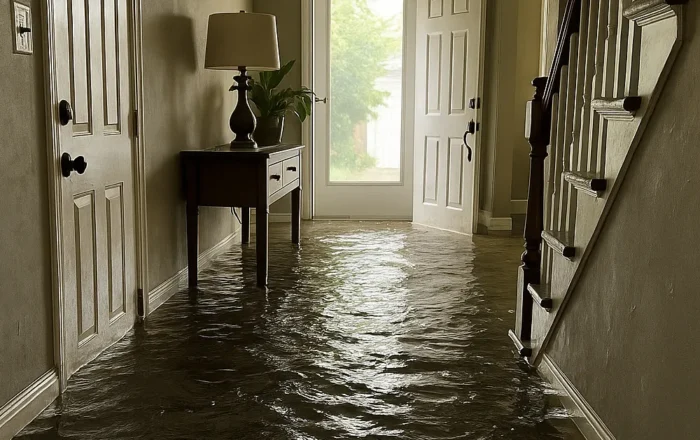What To Do If Your House is Flooding
4 minute readIf your house is flooding, act fast but stay safe.
Home > BKV Energy Blog > All Posts > What is the Average Electric Bill in Texas?
4 minute read • Last update March 2025

The average residential monthly electric bill in Texas is $165.82.
This is calculated by multiplying the average kWh usage of 1,146 by the average price per kWh of $0.1446. This data was provided by the U.S. Energy Information Administration’s (EIA) latest annual report from 2023 on average residential energy sales and pricing.
It’s important to note that electricity bills can vary significantly throughout the year due to changes in outdoor temperature. Your home can use three times as much electricity to power your air conditioner in July and August compared to milder months such as March or November.
In Texas, average monthly electric bills are higher because our summers are hotter and longer. Our air conditioners have to work much harder to keep our homes comfortable and safe from often triple-digit temperatures. Not only are we using more energy to keep our homes cool, but the hot climate also increases the cost of energy production. In the summer, this pushes the average price per kWh even higher.
Summers are not the only cause for higher bills in Texas. Up towards the panhandle, residents face harsh winter temperatures and those bitter cold days require lots of energy to keep homes warm.
According to the EIA, the average monthly kilowatt-hour usage in Texas was 1,146 kWh in 2023. The national average for monthly electricity usage was 855 kWh per month. As you can see, Texas is considerably higher than the national average.
There are two main factors that impact Texas’ high average monthly kWh usage: long, hot summers and larger-than-average homes.
Energy consumption in Texas varies significantly with the seasons due to the state’s extreme climate patterns. During the hot summer months, electricity usage spikes closer to 1,400 kWh as air conditioners work overtime to combat high temperatures, often exceeding 100°F in many regions.
Conversely, energy demand tends to be more moderate during the milder fall and spring months, offering a reprieve from heavy cooling or heating needs. In winter, while Texas generally experiences less severe cold compared to northern states, occasional cold snaps can lead to increased heating requirements, especially in homes using electric heating systems.
You can calculate the average bill for a variety of home sizes by multiplying the average price per kWh and the average kWh usage. While these average bills can give Texans a good idea of whether they are paying a reasonable amount for electricity, it’s important to remember that electricity bills can vary widely throughout the year due to changes in weather, demand for energy, and the frequency of use of appliances such as clothes washing machines, dishwashers, ovens, microwaves, and televisions.
| Type of home | Estimated kWh usage | Price per kWh | Avg. monthly electric bill |
|---|---|---|---|
| One-bedroom apartments | 500 kWh | $0.1439 | $71.95 |
| Two-bedroom apartments | 650 kWh | $0.1439 | $93.53 |
| Small-medium size homes | 1000 kWh | $0.1439 | $143.90 |
| Larger homes | 1800 kWh | $0.1439 | $259.02 |
The average monthly electricity bill for an apartment in Texas will be around $71.95 in 2022. This is calculated by multiplying the average price per kWh of $0.1439 and 500 kWh, a typical usage for a one-bedroom apartment.
The average monthly electric bill for a two-bedroom apartment in Texas will be around $93.53 in 2022, given the two-bedroom apartment uses an average of 650 kWh per month.
An average electric bill for a small-to-medium-sized home in Texas will land at about $143.90 in 2022. We come to this estimate by multiplying the average price per kWh and 1000 kWh, which is a normal level of energy use for a small or medium-sized home.
An average energy bill for a large Texas home would come to about $259.02 in 2022. You can calculate this average bill estimate by multiplying the average price per kWh and 1800 kWh, a reasonable level of electricity use for a larger home.

There are several ways to lower your spending on electricity by reducing your usage. Here are a few of the most impactful changes you can make:
In addition to reducing how much electricity you use, you can also change your energy plan to find a lower price per kWh. One thing to look out for is bill credit plans that offer credits for using a specific amount of energy. They advertise a low kWh rate, but only if you fall within their range, which can be very difficult, especially during a Texas summer.
At BKV Energy, we highly recommend selecting a simple fixed-rate electricity plan without any gimmicks such as free nights, free weekends, or bill credits. Often, those plans are designed to appear like a more affordable option while costing you more. Explore BKV Energy’s cost-effective energy plans in your area by entering your zip code.
Graham Lumley, Digital Marketing Manager at BKV Energy, leads digital and traditional marketing strategies, focusing on educating Texans about the state's deregulated energy market. With over 8 years of marketing experience, he creates content to help consumers understand and save on their energy bills, bringing a fresh and dynamic approach to the industry.

If your house is flooding, act fast but stay safe.

Learn more about property taxes by region in Texas
Get $50 off your electric bill!
Use code BKVEJOINUS50
Enter your zip code to shop BKV Energy's affordable, fixed-rate Texas electricity plans. Use the promo code for $50 off your electric bill.